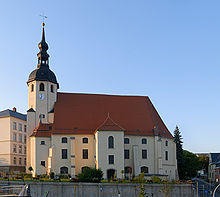St. Peter and Paul (Reichenbach)
The Protestant town church St. Peter and Paul is a baroque hall church in Reichenbach in the Vogtlandkreis in Saxony . It belongs to the Reichenbach parish in the Plauen church district of the Evangelical Lutheran Church of Saxony and is known for its organ by Gottfried Silbermann , which, however, after several renovations, hardly contains any original substance.
History and architecture
Today's baroque hall church was rebuilt in the years 1721/22 in place of a previous building from the 13th century that was destroyed in a town fire in 1720 and probably already changed several times. In the years 1905/1906 a bridal hall was added, the west portal was added and the interior was renewed. Further restorations took place in 1963/1964 on the inside and since 1996 on the outside.
The church is a stately plastered building with a three-sided east end, buttresses and side porches. The lower part of the west tower, built over a square floor plan, probably dates from the Romanesque period and was completed with an octagonal bell storey with a Baroque dome from 1780. The neo-Romanesque arched portal is provided with a relief representation of Christ and the apostles Peter and Paul . The sacristy forms a low extension in the southeast.
Inside, the church is a spacious plastered building with a flat stucco ceiling and surrounding two-storey galleries. The slightly convex organ loft is carved with the family coat of arms of the von Metzsch family . On the lower gallery in the north there are two large carved lion figures holding the Reichenbach city coat of arms with the apostle Peter on a wall between two towers.
Furnishing
A splendid baroque pulpit altar from the years 1723–1727 shows painted representations on the pulpit between columns of Christ's commission to John as well as the prophets Elijah and presumably Isaiah , on the side are carved figures of the apostles Peter and Paul and above a coronet as a crown. The round marble baptism and the lectern date from around 1723. A life-size wooden crucifix from around 1680 and another boxwood crucifix from the middle of the 17th century have been preserved. Two large oil paintings by Ludwig Otto from 1914 show Christ's arrival with Martha and Maria as well as Christ and Nicodemus . Four portraits of pastors from the second and third third of the 18th century have been preserved in the bridal hall.
organ
The organ was originally a work by Gottfried Silbermann from 1725 with originally 29 registers on two manuals and a pedal . After remaining hitherto spared from major surgery, she was first in 1906 and later in 1927 Jehmlich rebuilt and expanded, with the original slider chests by cone chests with pneumatic tracker action replaces and disposition were changed engagingly. Nevertheless, 22 registers of the organ were wholly or partially preserved.
In the years 1971/1972 the organ was built from scratch by the Jehmlich company with 26 registers on two manuals and a pedal in a historicizing design using wooden pipes from four pedal registers, the bass pipes of the Gedackt 8 ′ and the wooden parts of the case. Today's disposition is:
|
|
|
|||||||||||||||||||||||||||||||||||||||||||||||||||||||||||||||||||||||||||||||||||||
- Tremulant (upper work)
- Oberw. at Hauptw.
- Main on pedal
- Oberw. on pedal
- Remarks
- Pitch: currently a 1 = 442.5 Hz
- Mood: equal.
- Wind pressure: main unit and pedal 85 mm water column , upper unit: 80 mm water column
Peal
The ringing consists of three cast steel bells and a bronze bell , the bell cage is made of steel and the bell yokes are made of cast steel. Below is a data overview of the bell:
| No. | Casting date | Caster | material | diameter | Dimensions | Chime |
|---|---|---|---|---|---|---|
| 1 | 1950 | Bell foundry Schilling & Lattermann | Cast steel | 1630 mm | 2034 kg | it' |
| 2 | 1950 | Bell foundry S. Schilling | bronze | 1100 mm | 797 kg | ges ′ |
| 3 | 1950 | Bell foundry Schilling & Lattermann | Cast steel | 1274 mm | 903 kg | G' |
| 4th | 1950 | Bell foundry Schilling & Lattermann | Cast steel | 1055 mm | 522 kg | b ′ |
literature
- Georg Dehio : Handbook of the German art monuments. Saxony II. The administrative districts of Leipzig and Chemnitz. Deutscher Kunstverlag, Munich / Berlin 1998, ISBN 3-422-03048-4 , p. 837.
- Rainer Thümmel : Bells in Saxony . Sound between heaven and earth. Ed .: Evangelical Regional Church Office of Saxony . 2nd, updated and supplemented edition. Evangelische Verlagsanstalt, Leipzig 2015, ISBN 978-3-374-02871-9 , p. 348 (With a foreword by Jochen Bohl and photographs by Klaus-Peter Meißner}).
Web links
- Website of the Evangelical Lutheran Parish Reichenbach
- Reichenbach - organ from 1727 on the website of the Gottfried Silbermann Society
Individual evidence
- ↑ Frank-Harald Greß, Michael Lange: Die Orgeln Gottfried Silbermanns (= publications of the Society of Organ Friends. No. 177). 2nd Edition. Sandstein-Verlag, Dresden 2001, ISBN 3-930382-50-4 , pp. 145-147.
- ^ A b Rainer Thümmel : Bells in Saxony . Sound between heaven and earth. Ed .: Evangelical Regional Church Office of Saxony . 2nd, updated and supplemented edition. Evangelische Verlagsanstalt, Leipzig 2015, ISBN 978-3-374-02871-9 , pp. 348 (With a foreword by Jochen Bohl and photographs by Klaus-Peter Meißner).
Coordinates: 50 ° 37 ′ 7.4 ″ N , 12 ° 18 ′ 16.4 ″ E

